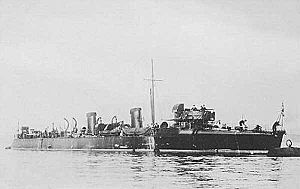HMS Ariel (1897) facts for kids

HMS Ariel
|
|
Quick facts for kids History |
|
|---|---|
| Name | HMS Ariel |
| Ordered | 1895 – 1896 Naval Estimates |
| Builder | John I Thornycroft, Chiswick |
| Yard number | 314 |
| Laid down | 23 April 1896 |
| Launched | 5 March 1897 |
| Commissioned | October 1898 |
| Fate | Wrecked, 19 April 1907 |
| General characteristics | |
| Class and type | Two funnel, 30 knot destroyer |
| Displacement |
|
| Length | 210 ft (64 m) o/a |
| Beam | 19 ft 9 in (6.02 m) |
| Draught | 7 ft 8 in (2.34 m) |
| Installed power | 5,700 shp (4,300 kW) |
| Propulsion |
|
| Speed | 30 kn (56 km/h) |
| Range |
|
| Complement | 65 officers and men |
| Armament |
|
| Service record | |
HMS Ariel was a fast warship called a destroyer, built for the Royal Navy. It was designed to be very quick, able to reach speeds of 30 knots (about 55 kilometers per hour). The ship was named after a famous "airy spirit" from Shakespeare's play The Tempest, or a similar spirit from the Bible. Ariel was the ninth ship in the Royal Navy to carry this name. It was launched in 1897 and served in different locations before it was sadly wrecked in a storm in 1907.
Contents
Building a Fast Destroyer
Designing HMS Ariel
The British Royal Navy wanted two new, very fast warships. They ordered them from a company called John I. Thornycroft & Company. These ships were designed to be "thirty-knotters," meaning they could travel at least 30 knots. Ariel was built just like four other fast destroyers Thornycroft had made earlier.
The design for Ariel included three special water-tube boilers. These boilers made steam at high pressure to power two large steam engines. These engines were very powerful, giving the ship about 5,700 horsepower. This power allowed Ariel to reach its high speeds. The ship had two tall funnels where the smoke from the engines came out.
Size and Features
Ariel was about 64 meters (210 feet) long from end to end. It was about 6 meters (19 feet 6 inches) wide. When fully loaded, the ship weighed about 352 tons. A crew of 63 officers and sailors worked on board.
The ship was armed with several guns and torpedoes. It had one large 12-pounder gun, which was about 76 millimeters (3 inches) in size. It also had five smaller 6-pounder guns. For attacking other ships, Ariel carried two torpedo tubes. These tubes could launch 450-millimeter (18-inch) torpedoes. The front part of the ship had a curved, protective deck called a "turtleback forecastle."
Construction Timeline
The building of Ariel began on 23 April 1896 at Thornycroft's shipyard in Chiswick, which is on the River Thames. The ship was officially launched into the water on 5 March 1897.
After it was built, Ariel went through special tests called sea trials. During these tests, it proved it could go faster than 30 knots. It reached a speed of 30.82 knots over a measured mile. Ariel was officially finished and ready for service in October 1898.
Life at Sea
Early Service
After it was ready, Ariel was sent to a group of ships called the Harwich Flotilla, based at Chatham. In 1899, it took part in training exercises with another ship called HMS Angler. The next year, Ariel was used for training new sailors as part of the Medway Instructional Flotilla.
Serving in the Mediterranean
On 22 August 1901, Ariel was officially put into service at Chatham. It had a crew of 60 people and was sent to the Mediterranean Sea. When it arrived in Gibraltar, Ariel took over from another ship, HMS Hornet. It then served as a smaller support ship for HMS Cormorant. On 3 December 1901, Ariel arrived in Malta from Gibraltar.
The Ship's Final Journey
On 19 April 1907, HMS Ariel was unfortunately wrecked. It ran aground, meaning it hit the bottom, on a breakwater (a wall built to protect a harbor) outside Grand Harbour, Valletta, Malta. This happened at night during a storm. Luckily, all the sailors on board survived. They were rescued by another destroyer, HMS Bruiser.

